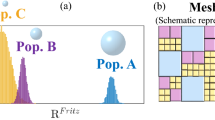Abstract
A new convection—penetration model for mass transfer of indicator ions to a gas-evolving electrode with forced convection of solution is described theoretically. It has been found that the mass transfer of indicator ions to a gas-evolving electrode can be described well by the new model. The contribution of an oxygen bubble departing from the electrode surface to the mass transfer is much greater than the contribution of a departing hydrogen bubble.
Similar content being viewed by others
Abbreviations
- α d :
-
proportionality factor
- A d :
-
average cross-section of detached bubbles; bubble cross-section (m2)
- A e :
-
surface area of electrode (m2)
- c i :
-
concentration of speciesi in bulk solution (mol m−3)
- d :
-
bubble density of sites from which bubbles depart (m−2)
- D i :
-
diffusion coefficient of species i (m2 s−1)
- E :
-
electrode potential versus SCE (V)
- F :
-
Faraday constant, = 96.487 106 C kmol−1
- i :
-
electric current density (kA m−2)
- I :
-
electric current (kA)
- k i :
-
mass transfer coefficient of the indicator ion i (m s−1)
- ke, i :
-
mass transfer coefficient of the indicator ion i obtained by extrapolation ofk i/i curve (m s−1)
- k f, i :
-
mass transfer coefficient of the indicator ion i at forced convection in absence of gas bubble evolution (m s−1)
- k ′i :
-
mass transfer coefficient of the indicator ion i in convectionless conditions for the part of electrode surface from which a bubble had departed (m s−1)
- k ′i, a :
-
average value ofk ′i for periodt d (m s−1)
- k ′f, i :
-
mass transfer coefficient of the indicator ion i at forced convection for the part of electrode surface from which a bubble had departed (m s−1)
- k ′f, i, a :
-
average value ofk ′f, i for periodt 1 (m s−1)
- k ′f, i, a * :
-
average value ofk ′f, i for periodt d (m s−1)
- m i :
-
mass flux density of the indicator ion i (mol m−2 s)
- N :
-
number of detached bubbles per unit surface area and time (cm−2 s−1)
- n :
-
number of bubbles on a picture or on a part of a moving film (1)
- n :
-
number of electrons, involved in the reaction to form one molecule of a species (1)
- p :
-
a proportionality factor
- R d :
-
average radius of departed bubbles; bubble radius (m)
- R d, i :
-
radius of the departed bubble i (m)
- R d, m :
-
maximum radius of departed bubble m (m)
- R S, d :
-
Sauter bubble radius; RS, d = 3Vd/4Ad (m)
- s :
-
fraction of electrode surface coming into contact with fresh bulk electrolyte in periodt d (1)
- t :
-
time (s)
- t d :
-
bubble cycle time (s)
- t 1 :
-
time Di/πk f, i 2 (s)
- T :
-
temperature (K)
- ν g :
-
volumetric gas production rate (m s−1)
- ν g, b :
-
volumetric production rate of gas bubbles (m s−1)
- ν 0g :
-
volumetric production rate of gas bubbles when all the gas is evolved as bubbles (ms−1)
- ν s :
-
solution flow velocity (m s−1)
- V d :
-
average volume of departed bubbles; bubble volume (m3)
- V M :
-
volume of 1 mol gas; 24.4 × 10−3 m3 at 298 K(m3 mol−1)
- η g :
-
efficiency of gas bubble evolution (%)
- a:
-
average value
- b:
-
bubbles
- d:
-
detached bubble
- e:
-
electrode; extrapolated
- f:
-
forced convection
- fi:
-
ferricyanide ion
- fo:
-
ferrocyanide ion
- g:
-
gas
- H:
-
hydrogen
- i:
-
indicator ion i
- m:
-
maximum
- O:
-
oxygen
- s:
-
solution
References
H. Vogt in ‘Comprehensive Treatise of Electrochemistry’ (edited by E. Yeager, J.O.'M. Bockris, B. E. Conway and S. Sarangapani) Vol. 6, Plenum Press, New York, London (1983) p. 445.
N. Ibl, E. Adam, J. Venczel and E. Schalen,Chem. Ing. Tech. 43 (1971) 202.
K. Stephan and H. Vogt,Electrochim. Acta 24 (1979) 11.
L. J. J. Janssen and S. J. D. van Stralen,ibid. 26 (1981) 1011.
L. L J. Janssen and E. Barendrecht,ibid. 24 (1979) 693.
I. Rousar and V. Chezner,ibid. 20 (1975) 289.
T. R. Beck,J. Electrochem. Soc. 116 (1969) 1038.
H. Vogt,Electrochim. Acta 23 (1978) 205.
L. J. J. Janssen and E. Barendrecht,ibid., to be published.
L. J. J. Janssen and J. G. Hoogland,ibid. 18 (1973) 543.
L. J. J. Janssen, C. W. M. P. Sillen, E. Barendrecht and S. J. D. van Stralen,ibid. 29 (1984) 633.
H. Vogt, Extended Abstracts 34th meeting ISE, Erlangen, 0413, 1983.
Author information
Authors and Affiliations
Rights and permissions
About this article
Cite this article
Janssen, L.J.J., Barendrecht, E. Mass transfer at gas evolving electrodes. J Appl Electrochem 15, 549–555 (1985). https://doi.org/10.1007/BF01059296
Received:
Issue Date:
DOI: https://doi.org/10.1007/BF01059296



